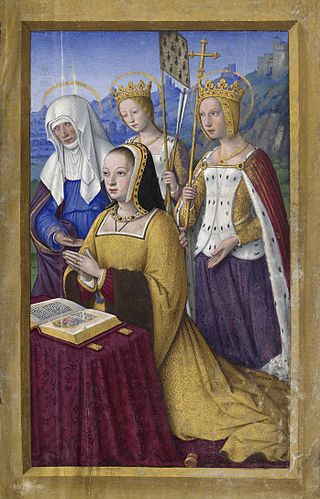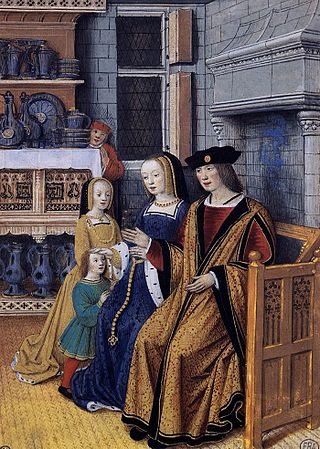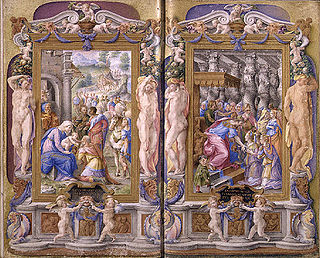
JeanFouquet was a French painter and miniaturist. A master of panel painting and manuscript illumination, and the apparent inventor of the portrait miniature, he is considered one of the most important painters from the period between the late Gothic and early Renaissance. He was the first French artist to travel to Italy and experience first-hand the early Italian Renaissance.

Books of hours are Christian prayer books, which were used to pray the canonical hours. The use of a book of hours was especially popular in the Middle Ages, and as a result, they are the most common type of surviving medieval illuminated manuscript. Like every manuscript, each manuscript book of hours is unique in one way or another, but most contain a similar collection of texts, prayers and psalms, often with appropriate decorations, for Christian devotion. Illumination or decoration is minimal in many examples, often restricted to decorated capital letters at the start of psalms and other prayers, but books made for wealthy patrons may be extremely lavish, with full-page miniatures. These illustrations would combine picturesque scenes of country life with sacred images.

The Très Riches Heures du Duc de Berry, or Très Riches Heures, is an illuminated manuscript that was created between c. 1412 and 1416. It is a book of hours, which is a Christian devotional book and a collection of prayers said at canonical hours. The manuscript was created for John, Duke of Berry, the brother of King Charles V of France, by Limbourg brothers Paul, Johan and Herman. The book is now MS 65 in the Musée Condé, Chantilly, France.

Simon Marmion was a French and Burgundian Early Netherlandish painter of panels and illuminated manuscripts. Marmion lived and worked in what is now France but for most of his lifetime was part of the Duchy of Burgundy in the Southern Netherlands.

The Hours of Catherine of Cleves is an ornately illuminated manuscript in the Gothic art style, produced in about 1440 by the anonymous Dutch artist known as the Master of Catherine of Cleves. It is one of the most lavishly illuminated manuscripts to survive from the 15th century and has been described as one of the masterpieces of Northern European illumination. This book of hours contains the usual offices, prayers and litanies in Latin, along with supplemental texts, decorated with 157 colorful and gilded illuminations. Today, both parts of the manuscript that forms this book are housed at the Morgan Library and Museum in New York City.

William de Brailes was an English Early Gothic manuscript illuminator, presumably born in Brailes, Warwickshire. He signed two manuscripts, and apparently worked in Oxford, where he is documented from 1238 to 1252, owning property in Catte Street near the University Church of St Mary the Virgin, roughly on the site now occupied by the chapel of All Souls College, where various members of the book trade lived. He was married, to Celena, but evidently also held minor orders, as at least three self-portraits show him with a clerical tonsure. This was not unusual: by this date, and with the exception of the St Albans monk Matthew Paris, the only other English illuminator of the period about whom we have significant personal information, most English illumination seems to have been done in commercial workshops run by laymen.

Michelino Molinari da Besozzo was a notable fifteenth century Italian painter and illuminator, who was widely praised for his work. He worked mostly in Milan and Lombardy, and was employed by the Visconti family, rulers of Milan. Michelino's work follows the traditions of the Lombard School, and maintains the Trecento style.

The Belles Heures of Jean de France, Duc de Berry, or Belles Heures of Jean de Berry is an early 15th-century illuminated manuscript book of hours commissioned by the French prince John, Duke of Berry, around 1409, and made for his use in private prayer and especially devotions to the Virgin Mary. The miniatures of the Belles Heures are mostly painted by the Limbourg brothers; very few books of hours are as richly decorated as it.

The Rothschild Prayerbook or Rothschild Hours, is an important Flemish illuminated manuscript book of hours, compiled c. 1500–1520 by a number of artists.

The Grandes Heures of Anne of Brittany is a book of hours, commissioned by Anne of Brittany, Queen of France to two kings in succession, and illuminated in Tours or perhaps Paris by Jean Bourdichon between 1503 and 1508. It has been described by John Harthan as "one of the most magnificent Books of Hours ever made", and is now in the Bibliothèque nationale de France, catalogued as Ms lat. 9474. It has 49 full-page miniatures in a Renaissance style, and more than 300 pages have large borders illustrated with a careful depiction of, usually, a single species of plant.

The Hours of James IV of Scotland, Prayer book of James IV and Queen Margaret is an illuminated book of hours, produced in 1503 or later, probably in Ghent. It marks a highpoint of the late 15th century Ghent-Bruges school of illumination and is now in the Austrian National Library in Vienna. It is thought to have been a wedding gift from James IV of Scotland or another Scottish nobleman to James's wife Margaret Tudor on the occasion of their marriage, perhaps finishing a book already started for another purpose. A number of artists worked on the extensive programme of decoration, so that "the manuscript in its entirety presents a rather odd picture of heterogeneity". The best known miniature, a full-page portrait of James at prayer before an altar with an altarpiece of Christ and an altar frontal with James's coat-of-arms, gave his name to the Master of James IV of Scotland, who is now generally identified as Gerard Horenbout, court painter to Margaret of Austria; he did only one other miniature in the book. The equivalent image of Margaret is the only image by another artist, using a rather generic face for the queen's portrait, and in a similar style to that of the Master of the First Prayer Book of Maximilian. Other artists worked on the other miniatures, which include an unusual series of unpopulated landscapes in the calendar – perhaps the Flemish artists were not sure how Scots should be dressed.

The Black Hours, MS M.493 is an illuminated book of hours completed in Bruges between 1460 and 1475. It consists of 121 pages (leaves) with Latin text written in Gothic minuscule script. The words are arranged in rows of fourteen lines and follow the Roman version of the texts. The lettering is inscribed in silver and gold and placed within borders ornamented with flowers, foliage and grotesques, on pages dyed a deep blueish black; hence its designation as a Black books of hours. The book contains fourteen full-page miniatures and opens with the months of the liturgical calendar, followed by the Hours of the Virgin, and ends with the Office of the Dead.

Jean Bourdichon was a French painter and manuscript illuminator at the court of France between the end of the 15th century and the start of the 16th century, in the reigns of Louis XI of France, Charles VIII of France, Louis XII of France, and Francis I of France. He was probably born in Tours, and was a pupil of Jean Fouquet. He died in Tours.

The Hours of Henry VIII is a 15th-century illuminated book of hours, painted by Jean Poyet in Tours. Its 400 pages contain 55 full-page miniatures. It is housed under shelfmark MS H.8 in the Morgan Library & Museum, New York.

The Hours of Louis XII was an illuminated manuscript book of hours produced by Jean Bourdichon for Louis XII of France. It was begun in 1498 or 1499, going by the king's age of 36 given below his portrait; he became king on 7 April 1498. The book reached England, where it was broken up around 1700. Now only parts of it survive – in total sixteen full-page miniature paintings, two sheets of text and fifty-one sheets of text bound in the wrong order as a thin volume.

The Book of hours of Frederick of Aragon or simply the Hours of Frederick of Aragon is a luxury book of hours, a private devotional book, made for Frederick of Aragon between 1501 and 1502. Described as a "particularly accomplished work of art", it is the result of cooperation between three different artists, Ioan Todeschino, Jean Bourdichon, and the Master of Claude de France. The 62 full-page miniatures were made by Bourdichon, and have been described as some of his best work, while the border decorations were made by Todeschino and the Master of Claude de France. Following the death of Frederick, the book probably eventually ended up in Spain, and eventually entered the library of Joseph Bonaparte. It was eventually lost by him and finally bought by the predecessor of today's Bibliothèque nationale de France, the French national library, in 1828. It is kept in the library collections in Paris and has been exhibited to the public on several occasions.

The Master of Jouvenel was an anonymous master illuminator active between 1447 and 1460. The painter, to whom many manuscripts are attributed, was undoubtedly at the head of a workshop, also called Groupe Jouvenel from which the Master of Boccace of Geneva came from, or the Master of Boethius. The painter owes his name to a manuscript in the Mare Historium commissioned by Guillaume Jouvenel des Ursins, for which his workshop produced 730 miniatures.

Étienne Colaud was a French illuminator and book dealer, active in Paris between 1512 and 1540. A number of surviving archives indicate that he was based on the Île de la Cité, close to the cathedral of Notre-Dame, and that other family members also worked in the book trade. His clientele came from leading families of the time, including great land owners, top prelates, and even the king himself. Using a Book of hours that carries his name, scholars have attributed approximately twenty manuscripts to him by analysing the techniques and style applied. There are also a number of religious books, translations into French from Latin or Italian, chivalric narratives and illuminated texts. Étienne Colaud's style is strongly influenced by his near contemporary, the Parisian illuminator Jean Pichore, but his work indicates that he was also networked with virtually every other Paris book-artist of the period.

Renaissance illumination refers to the production of illuminated manuscripts in Western Europe in the late 15th and 16th centuries, influenced by the representational techniques and motifs of Renaissance painting. With the invention of printing, book painting did not disappear abruptly, but continued in certain luxury manuscripts, and even in some printed works. Illuminators of the period used techniques of perspective representation and iconographic themes specific to the period. Restricted to luxury works, this type of production declined in the second half of the 16th century, as engraving became increasingly competitive.
The Master of Cardinal de Bourbon was an anonymous master illuminator active in France between 1470 and 1500. His name was inspired by the manuscript evoking the life and miracles of Saint Louis, illuminated for the cardinal and archbishop of Lyon, Charles II de Bourbon. Little is known about his career, which is largely based on conjecture. Born in Flanders, he trained in the orbit of the Master of Margaret of York's group in the Bruges region. He may have passed through Rouen in the 1470s, before settling in Paris in the 1480s, where he illuminated a large number of manuscripts for relatives of King Louis XI. It has been suggested that he was identified with Guérard Louf, a painter and sculptor from Utrecht who settled in Rouen, but this identification has since been called into question.























